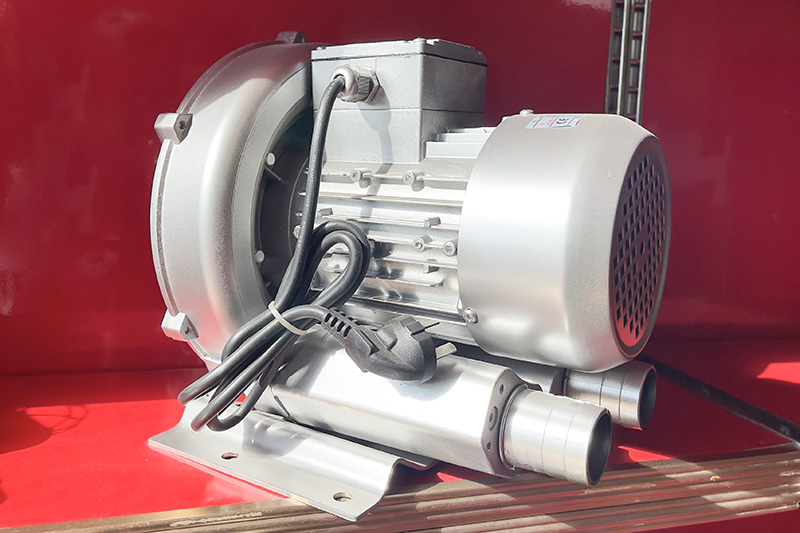Installation matters
1. The installation of the whole centrifugal fan unit should be placed directly on the foundation and leveled with pairs of inclined horns.
2. For centrifugal fans assembled on site, the cutting surface on the base should be properly protected, and there should be no rust or operation. When the base is placed on the foundation, it should be leveled with a pair of inclined horns.
3. The bearing seat and the base should be closely connected, and the longitudinal unlevelness should not exceed 0.2/1000. Use a spirit level to measure on the main shaft. Measurement.
4. Before grinding and scraping the bearing bush, the axis of the rotor and the axis of the casing should be corrected, and the gap between the impeller and the air inlet and the gap between the main shaft and the shaft hole of the rear side plate of the casing should be adjusted to meet the equipment technology. document requirements.
5. When the main shaft and bearing bush are assembled, they should be checked according to the provisions of the equipment technical documents. An interference of 0.03-0.04 mm should be maintained between the bearing cover and the bearing pad (measure the outer diameter of the bearing pad and the inner diameter of the bearing seat).
6. When assembling the fan casing, the position of the casing should be aligned based on the rotor axis line and the axial and radial clearances between the impeller air inlet and the casing air inlet should be adjusted to the range specified in the equipment technical documents. inside, and check whether the anchor bolts are tight. If the clearance value is not specified in the equipment technical documents, the general axial clearance should be 1/100 of the outer diameter of the impeller, and the radial clearance should be evenly distributed, and the value should be 1.5/1000 ~ 3/1000 of the outer diameter of the impeller (outer diameter). The smaller diameter takes the larger value). When adjusting, try to make the gap smaller to improve the fan efficiency.
7. When the fan is aligning, the different axial degrees of the fan shaft and the motor shaft: the radial positioning displacement should not exceed 0.05 mm, and the inclination should not exceed 0.2/1000.
8. Centrifugal fans equipped with rolling bearings, the different axial degrees of the bearing holes on the two bearing frames can be flexibly rotated after the rotor is installed.
Debug method
Centrifugal fan is a device with complex structure, mainly composed of air inlet, air valve, impeller, motor, and air outlet. In different states, the effect of the centrifugal fan is also different. Therefore, the operating conditions of different parts are not uniform, and the effect of the centrifugal fan will be affected. There are many ways to debug the centrifugal fan to the best state.
1. Centrifugal fans are allowed to start at full voltage or to reduce voltage, but it should be noted that the current at full voltage starting is about 5-7 times the rated current, and the voltage reduction starting torque is proportional to the square of the voltage. When the grid capacity is insufficient, A voltage drop start should be used.
2. During the test run of the centrifugal fan, you should read the product manual carefully and check whether the wiring method is consistent with the wiring diagram; you should carefully check whether the working voltage of the power supply to the fan meets the requirements, whether the power supply is out of phase or in the same phase, and whether the electrical components are distributed. Whether the capacity meets the requirements.
3. There should be no less than two people during the test run, one person controls the power supply, the other person observes the operation of the fan, and immediately stops the inspection if any abnormality is found; first, check whether the rotation direction is correct; after the centrifugal fan starts to run, immediately check whether the running current of each phase is balanced. , Whether the current exceeds the rated current; if there is any abnormal phenomenon, it should be stopped for inspection. After running for five minutes, stop the fan to check whether there is any abnormal phenomenon, and then start the operation after confirming that there is no abnormal phenomenon.
4. During the test run of the two-speed centrifugal fan, start at low speed first to check whether the rotation direction is correct; when starting at high speed, the fan must be stopped before starting to prevent the high-speed reverse rotation, which will cause the switch to trip and the motor to be damaged.
5. When the centrifugal fan reaches the normal speed, it should be measured whether the input current of the fan is normal, and the running current of the centrifugal fan should not exceed its rated current. If the operating current exceeds its rated current, check whether the supplied voltage is normal.
6. The motor power required by the centrifugal fan means that under certain working conditions, the power required for the centrifugal fan and the fan box is larger when the air inlet is fully opened. There is a risk of damage to the motor if the air inlet is fully opened for operation. It is best to close the valve on the fan inlet or outlet pipe during the fan test, and gradually open the valve after operation until the required working condition is reached, and pay attention to whether the fan's operating current exceeds the rated current.
Debugging the centrifugal fan in strict accordance with the above debugging methods can make the efficiency of the centrifugal fan reach more than 98%.








